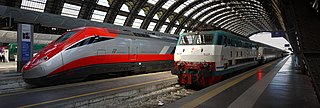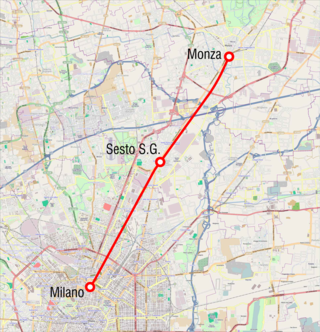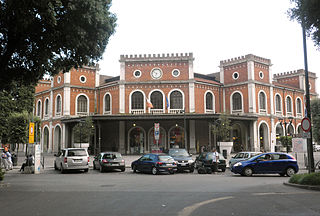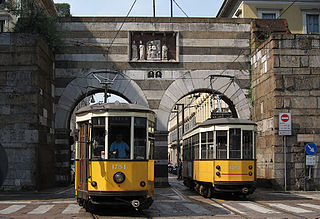
Milano Centrale is the main railway station of the city of Milan, Italy, and is the second railway station in Italy for passenger flow and the largest railway station in Europe by volume.

The Italian railway system is one of the most important parts of the infrastructure of Italy, with a total length of 24,227 km (15,054 mi) of which active lines are 16,723 km (10,391 mi). The network has recently grown with the construction of the new high-speed rail network. Italy is a member of the International Union of Railways (UIC). The UIC Country Code for Italy is 83.

The Milan Metro is the rapid transit system serving Milan, Italy, operated by Azienda Trasporti Milanesi. The network consists of 5 lines with a total network length of 104.1 kilometres (64.7 mi), and a total of 113 stations, mostly underground. It has a daily ridership of about 1.4 million on weekdays. The Milan Metro is the largest system in Italy for length, number of stations and ridership; and the seventh longest in the European Union.

The Milan–Monza railway line is the second oldest railway in Italy. It was the first railway in the Kingdom of Lombardy–Venetia, part of the Austrian Empire, opening in 1840 as the Imperiale Regno Privilegiata Strada Ferrata da Milano a Monza and was 12.8 kilometres (8.0 mi) long.

The Milano–Chiasso railway line is an Italian state-owned railway connecting Milan to Como and Chiasso, Switzerland.

The Milan–Venice railway line is one of the most important railway lines in Italy. It connects the major city of Milan, in Lombardy, with the Adriatic Sea at Venice, in Veneto. The line is state-owned and operated by the state rail infrastructure company, Rete Ferroviaria Italiana that classifies it as a trunk line. The line is electrified at 3,000 volts DC.

Verona Porta Nuova is the main railway station of Verona, Italy. It is one of the two stations serving central Verona; the other station, Verona Porta Vescovo, is located at the east of the city.

Milano Porta Garibaldi is a major railway station in the Italian city of Milan, located just to the north of the neighbourhood known as Porta Garibaldi. Porta Garibaldi is the city's main station for commuter traffic with 25 million passengers annually, although it is second to Centrale station considering total passenger traffic. The station is located on Piazza Sigmund Freud.

Cremona railway station is the main station serving the city and comune of Cremona, in the region of Lombardy, northern Italy. Located on the Pavia–Mantua railway, it is terminus of the lines linking Cremona with Treviglio, Brescia, Piacenza and Fidenza.

Varese railway station serves the town and comune of Varese, in the region of Lombardy, northern Italy. Opened in 1865, it is located on the Porto Ceresio–Milan railway.

Desenzano del Garda-Sirmione railway station serves the town and comune of Desenzano del Garda, in the region of Lombardy, northern Italy. Opened in 1854, it forms part of the Milan–Venice railway.

Lecco railway station is the main station serving the town and comune of Lecco, in the region of Lombardy, northern Italy. Opened in 1863, it is the junction of five lines, namely to Bergamo, to Como, to Milan, to Molteno and Monza and to Tirano.

Treviglio railway station, also known as Treviglio centrale railway station is the main station serving the town and comune of Treviglio, in the region of Lombardy, northern Italy. Opened in 1878, it has a higher average number of passengers per day than Treviglio's other railway station, Treviglio Ovest.

Voghera railway station serves the town and comune of Voghera, in the region of Lombardy, northern Italy. Opened in 1858, it forms part of the Alessandria–Piacenza railway, and is also the terminus of a railway from Milan via Pavia.
Milano Lambrate railway station is one of the main stations serving the city and comune of Milan, Italy.

Peschiera del Garda railway station serves the town and comune of Peschiera del Garda, in the region of Veneto, northern Italy. Opened in 1854, it forms part of the Milan–Venice railway.

The Milan tramway network is part of the public transport network of Milan, Italy, operated by Azienda Trasporti Milanesi (ATM).

The S5 is a commuter railway route forming part of the Milan suburban railway service, which converges on the city of Milan, Italy.

The S6 is a commuter rail route forming part of the Milan suburban railway service, which converges on the city of Milan, Italy.

The following outline is provided as an overview of and topical guide to Milan:




















